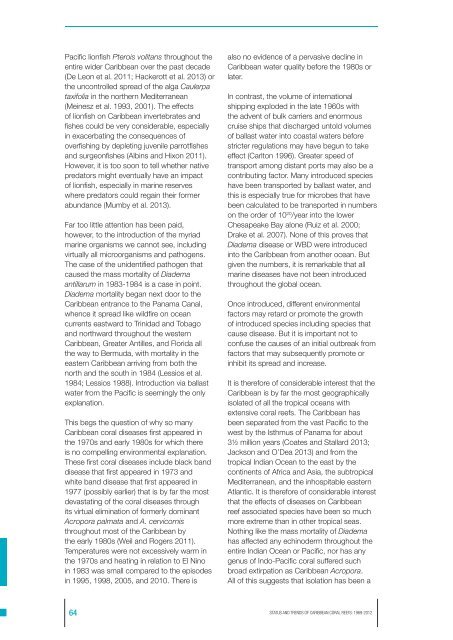Jackson2013-Status and Trendsof Caribbean Coral Reefs
Jackson2013-Status and Trendsof Caribbean Coral Reefs.pdf
Jackson2013-Status and Trendsof Caribbean Coral Reefs.pdf
Create successful ePaper yourself
Turn your PDF publications into a flip-book with our unique Google optimized e-Paper software.
Pacific lionfish Pterois volitans throughout the<br />
entire wider <strong>Caribbean</strong> over the past decade<br />
(De Leon et al. 2011; Hackerott et al. 2013) or<br />
the uncontrolled spread of the alga Caulerpa<br />
taxifolia in the northern Mediterranean<br />
(Meinesz et al. 1993, 2001). The effects<br />
of lionfish on <strong>Caribbean</strong> invertebrates <strong>and</strong><br />
fishes could be very considerable, especially<br />
in exacerbating the consequences of<br />
overfishing by depleting juvenile parrotfishes<br />
<strong>and</strong> surgeonfishes (Albins <strong>and</strong> Hixon 2011).<br />
However, it is too soon to tell whether native<br />
predators might eventually have an impact<br />
of lionfish, especially in marine reserves<br />
where predators could regain their former<br />
abundance (Mumby et al. 2013).<br />
Far too little attention has been paid,<br />
however, to the introduction of the myriad<br />
marine organisms we cannot see, including<br />
virtually all microorganisms <strong>and</strong> pathogens.<br />
The case of the unidentified pathogen that<br />
caused the mass mortality of Diadema<br />
antillarum in 1983-1984 is a case in point.<br />
Diadema mortality began next door to the<br />
<strong>Caribbean</strong> entrance to the Panama Canal,<br />
whence it spread like wildfire on ocean<br />
currents eastward to Trinidad <strong>and</strong> Tobago<br />
<strong>and</strong> northward throughout the western<br />
<strong>Caribbean</strong>, Greater Antilles, <strong>and</strong> Florida all<br />
the way to Bermuda, with mortality in the<br />
eastern <strong>Caribbean</strong> arriving from both the<br />
north <strong>and</strong> the south in 1984 (Lessios et al.<br />
1984; Lessios 1988). Introduction via ballast<br />
water from the Pacific is seemingly the only<br />
explanation.<br />
This begs the question of why so many<br />
<strong>Caribbean</strong> coral diseases first appeared in<br />
the 1970s <strong>and</strong> early 1980s for which there<br />
is no compelling environmental explanation.<br />
These first coral diseases include black b<strong>and</strong><br />
disease that first appeared in 1973 <strong>and</strong><br />
white b<strong>and</strong> disease that first appeared in<br />
1977 (possibly earlier) that is by far the most<br />
devastating of the coral diseases through<br />
its virtual elimination of formerly dominant<br />
Acropora palmata <strong>and</strong> A. cervicornis<br />
throughout most of the <strong>Caribbean</strong> by<br />
the early 1980s (Weil <strong>and</strong> Rogers 2011).<br />
Temperatures were not excessively warm in<br />
the 1970s <strong>and</strong> heating in relation to El Nino<br />
in 1983 was small compared to the episodes<br />
in 1995, 1998, 2005, <strong>and</strong> 2010. There is<br />
also no evidence of a pervasive decline in<br />
<strong>Caribbean</strong> water quality before the 1980s or<br />
later.<br />
In contrast, the volume of international<br />
shipping exploded in the late 1960s with<br />
the advent of bulk carriers <strong>and</strong> enormous<br />
cruise ships that discharged untold volumes<br />
of ballast water into coastal waters before<br />
stricter regulations may have begun to take<br />
effect (Carlton 1996). Greater speed of<br />
transport among distant ports may also be a<br />
contributing factor. Many introduced species<br />
have been transported by ballast water, <strong>and</strong><br />
this is especially true for microbes that have<br />
been calculated to be transported in numbers<br />
on the order of 10 20 /year into the lower<br />
Chesapeake Bay alone (Ruiz et al. 2000;<br />
Drake et al. 2007). None of this proves that<br />
Diadema disease or WBD were introduced<br />
into the <strong>Caribbean</strong> from another ocean. But<br />
given the numbers, it is remarkable that all<br />
marine diseases have not been introduced<br />
throughout the global ocean.<br />
Once introduced, different environmental<br />
factors may retard or promote the growth<br />
of introduced species including species that<br />
cause disease. But it is important not to<br />
confuse the causes of an initial outbreak from<br />
factors that may subsequently promote or<br />
inhibit its spread <strong>and</strong> increase.<br />
It is therefore of considerable interest that the<br />
<strong>Caribbean</strong> is by far the most geographically<br />
isolated of all the tropical oceans with<br />
extensive coral reefs. The <strong>Caribbean</strong> has<br />
been separated from the vast Pacific to the<br />
west by the Isthmus of Panama for about<br />
3½ million years (Coates <strong>and</strong> Stallard 2013;<br />
Jackson <strong>and</strong> O’Dea 2013) <strong>and</strong> from the<br />
tropical Indian Ocean to the east by the<br />
continents of Africa <strong>and</strong> Asia, the subtropical<br />
Mediterranean, <strong>and</strong> the inhospitable eastern<br />
Atlantic. It is therefore of considerable interest<br />
that the effects of diseases on <strong>Caribbean</strong><br />
reef associated species have been so much<br />
more extreme than in other tropical seas.<br />
Nothing like the mass mortality of Diadema<br />
has affected any echinoderm throughout the<br />
entire Indian Ocean or Pacific, nor has any<br />
genus of Indo-Pacific coral suffered such<br />
broad extirpation as <strong>Caribbean</strong> Acropora.<br />
All of this suggests that isolation has been a<br />
64 STATUS AND TRENDS OF CARIBBEAN CORAL REEFS: 1969-2012


















